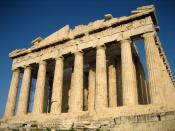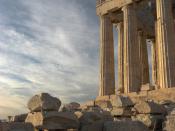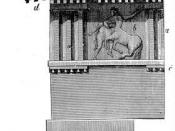"The Architect must recognize that process, not design, is the crux, and that the beauty and functional harmony of the building comes from a thousand small steps, taken one at a time, while the building is being designed, through the use of models, and then while the building is actually being made". This is one of the 16 guidelines stated in Christopher Alexander's "A Hippocratic Oath for Architects". So wouldn't the beauty of being an Architect be to create a masterpiece? To say that you dug your hands right in there and physically helped to build your masterpiece? I believe that if these 16 guidelines that Alexander wrote were implemented, it would give Architecture a whole new meaning. As a student, I think that the courses we would be instructed to take would be more fulfilling. We would have a wider range of understanding the entire concept of what the true meaning of being an Architect is.
As an architect, I would agree that if implemented, every building we produce should, and would be desirable. Each work would be its own masterpiece. This could futuristically help the world to make Architecture more modern and help to remove some of the bland buildings and houses we now have, to make newer, genuine ones. All of the repetition would soon be gone, and we would be living in a whole new atmosphere.
In past Architectural Eras, The Parthenon of Greece and the Pantheon of Rome are two of the most famous buildings. The Parthenon was built on religious belief to honor the Greek goddess, Athena. Located atop the Acropolis, the Parthenon can be seen for miles away. Being located centrally helps to allow with festive gatherings that were typically held in those days. The building is square in shape with 8 Doric columns across each end and 15 Doric columns along each side. They cage in the giant gold and ivory statue of Athena. The roof has two skewed sides with a triangular space underneath where many decorative carvings could be seen. The Pantheon of Rome is also a very spiritual building. It was built as a roman temple later transformed into a catholic church. Unlike the Parthenon's wide open space the Pantheon is very enclosed. This building is alternately a rectangular and semicircular space, separated under a dome by monolithic columns. There is a hole in the ceiling which carries light to certain places. This light is supposed to tell a story of Rome. The portico consists of three rows of columns and the dome has a span of 43.2m. It is located in the center of the Piazza Della Rotunda and it is a passageway from one type of architecture to another.
Three important concepts can describe the understanding of architecture, according to C.N. Schulz. These three concepts are Place, Path, and Domain. A place, by book definition is an area with definite or indefinite boundaries. A path is defined as a certain track or way of movement around and area. And the domain of an object is designed for an intended purpose, and contains certain requirements. Schulz believes that the combination of these three aspects should make a site specific atmosphere. For example, the Annex Auditorium has definite boundaries because it is an enclosed space with doors for exit and entrance. The path is the space in which students are able to circulate the room and make their way to the seats, which make up a part of the domain. The domain also consists of a room with good acoustics which allows the professor to speak, so that the students will clearly understand. These three concepts; Place, Path and Domain, are used whenever Schulz designs a structure.


